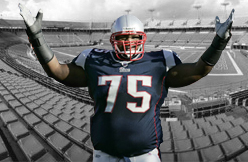FOXBORO - Adalius Thomas was caught completely off guard. He didn’t know Richard Seymour [stats] had been traded to Oakland when he walked into the Patriots [team stats] locker room yesterday, and had no answers for the rationale behind the move.
“I’m dumbfounded,” the stunned linebacker said. “I don’t know what to say.”
When asked how much Seymour meant to the defense, Thomas turned to sarcasm.
“Obviously nothing. He’s gone,” Thomas grumbled. “That’s the business. That’s how it goes. I really don’t know what to say without saying too much. I have no idea (what they’re thinking).”
So, what are they thinking?
Let’s just say Bill Belichick is not one to make a stunning move like this without having a clear plan not only for this season, but for several beyond. In the team’s press release announcing the trade, the Patriots coach indicated securing a first-round draft pick in 2011 for the defensive lineman brought “sufficient value and is in the long-term interest of the club.”
Does that long-term interest mean now having the cash to pay Vince Wilfork [stats], who is entering the final year of his contract? Does that mean the former Pro Bowl nose tackle will get his wish of a long-term contract extension to remain a Patriot for the foreseeable future?
On a lot of levels, it sure makes sense.
In terms of bookkeeping, Seymour was due to make $3.685 million this season. That money now comes off the Patriots salary cap.
While re-signing the five-time Pro Bowl end wasn’t likely and getting a value pick in return was a smart business move, perhaps in the big picture, keeping Wilfork and not allowing him to reach free agency is the greater prize. Along with having an extra first-round bargaining chip to use in 2011, or perhaps using it if a rookie cap is in place at that point, that’s where the “long-term interest” is better served.
The loss of Seymour actually enhances Wilfork’s value and worth. It can be argued Wilfork becomes more vital to the defense and its success. Even though Seymour wasn’t the dominant force he was in earlier years, he still took up two blockers and opened lanes for others, especially on the pass rush.
With him gone, Wilfork now is the only one left who merits that kind of attention. He’s the most important player in a 3-4 defense, and in a 4-3, he’s even more pivotal without Seymour taking up space at one end.
As of yesterday, however, there was nothing new on talks for a contract extension for Wilfork. That doesn’t mean the Pats won’t drop a dime on Kennard McGuire, who represents Wilfork, in the coming weeks. We’ll have to see if that’s the desired goal, and if not, where Belichick believes the extra cash may be better allocated.
For his part, a glum Wilfork yesterday voiced more concern about the break-up of one of the best defensive lines in the NFL, and having the ability to move on.
“We’re all professionals. Change happens all the time. Every year, you have change, you have roster change, you have everything change,” Wilfork said. “This is another change and we’re going to have to deal with it. I don’t care how you feel about it. You got to deal with it and move on.”
Moving on means a front line that won’t be nearly as good in the immediate future. The Seymour-Wilfork-Ty Warren [stats] trio stood as the strength of the defense. While the Pats do have excellent depth on the line, with Wilfork, Warren, Jarvis Green, Mike Wright and rookies Ron Brace and Myron Pryor, they won’t scare anyone, especially against the run in a 4-3 alignment.
Presumably, in the 4-3 they will have Derrick Burgess, Warren, Wilfork and Green up front. The two bookends aren’t exactly known as the greatest edge-setters against the run. Even substituting Tully Banta-Cain [stats] at one end, the same is true.
(bostonherald.com)


